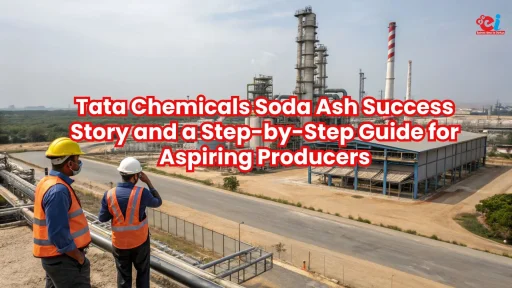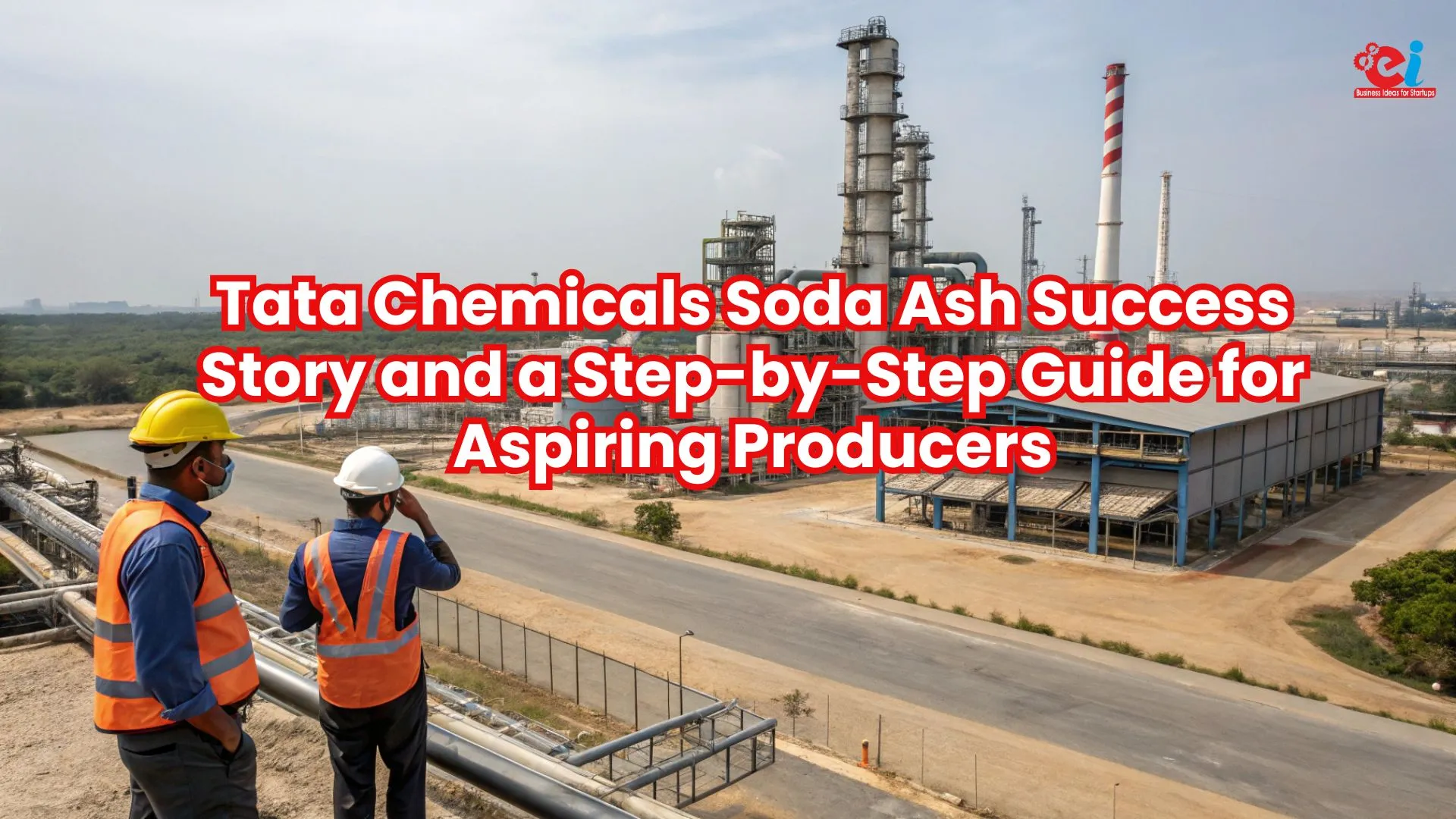Introduction: From Coastal Town to Global Influence
Mithapur, a coastal town in Gujarat by the Arabian Sea, is rarely linked to global industry. This small town became the hub of one of India’s most enduring chemical successes: the Tata Chemicals soda ash empire. Over the years, the company has created a production model combining engineering, sustainability, and business expertise.
Soda ash, also known as sodium carbonate, isn’t the most glamorous but it’s essential. It powers industries worldwide—from high‑rise glass to lithium batteries driving electric vehicles. Tata Chemicals soda ash journey showcases production excellence and reinvents the industry for a cleaner, sustainable future.
Learn how Tata Chemicals scaled soda ash production worldwide. See how entrepreneurs can use this strategy to build sustainable, competitive businesses.
Why Soda Ash Is More Relevant Than Ever
India ranks among the top five soda ash producers globally. It is seeing steady growth in domestic demand. Urbanization, rising disposable incomes, renewable energy initiatives, and expanding chemical‐processing centers have driven this increase. Global soda ash demand will rise as businesses and governments adopt greener buildings and cleaner energy systems.
It is important to note that this product isn’t just in high demand, it is constantly in demand. This is a highly profitable opportunity for entrepreneurs who want to establish businesses that are resilient with the ability to secure long-term buyers for industrial products, as well as B2B agreements, and the potential for exports to international markets.
Related: Profitable Opportunities in India’s Soda Ash Business Industry
Tata Chemicals Soda Ash Dual Production Mastery: Natural and Synthetic
During its growth, Tata Chemicals chose to adopt two production methods tailored to each location’s geography and resources.
At Lake Magadi in Kenya, Tata extracts trona—a natural sodium‑carbonate mineral. This method requires minimal external chemicals, instead relying on solar and natural heat drying. This Magadi operation is a perfect illustration of how low-impact, high-efficiency manufacturing is able to thrive in an area with a wealth of geological benefits.
Additionally, at India’s Mithapur plant the company has adopted the Solvay process, which is a synthetic method that involves brine, limestone, and ammonia.In the Solvay process, producers carbonate ammoniated brine with CO₂ to form sodium bicarbonate. They then dry and calcine the bicarbonate to yield high‑quality soda ash. This plant’s true brilliance lies in its closed‑loop efficiencies: it recovers and reuses ammonia, recycles CO₂, and treats effluents with advanced systems like Zero Liquid Discharge (ZLD) technology.
Both methods show not only the highest level of operational efficiency as well as the flexibility of Tata’s manufacturing model, which potential producers can learn from when they set up their operations across a variety of environments.
The Manufacturing Process: The Journey from Raw to Refined
A soda ash manufacturing plant is an exquisite orchestra of mechanical engineering, chemistry as well as automation and logistics. In order to set up an operation, business owners must first look into the supply of the raw materials, as well as utilities such as water and electricity, and the proximity to industries that end up using it.
The process begins with brine preparation–saltwater that is purified and dechlorinated. Limestone, a second key ingredient is crushed to a specific granularity, then examined for impurities. Ammonia is then injected into the brine under controlled conditions to make ammoniated brine. The solution is then transferred to carbonation towers where it reacts to carbon dioxide leading to the precipitation from sodium bicarbonate.
The bicarbonate slurry is taken through filtration and drying stages. After that, it undergoes calcination, a process that takes place which takes place between 150-200 degrees C, and decomposes the slurry into soda ash and releases CO2 and water. Effective systems can recover CO2 to reuse. The soda ash is chilled then graded based on size of the particle, packed and then kept in silos, or loaded to be sent for dispatch.
Each step require precise monitoring. From flow control to waste control and pollution management, the plant has to be a seamless highly-optimized system. Even a minor misalignment in the distribution of particle size or thermal control can impact the quality of products, especially in the case of food- or pharma-grade products.
Modern-day plants also incorporate real-time monitoring systems, usually driven with AI and IoT which monitor temperatures as well as the concentration of chemicals as well as energy consumption and even worker safety procedures. Tata Chemicals Soda Ash was one of the first companies to use Digital Twin technology in India’s chemical industry. Its engineers were able to simulate the entire process online before making changes to reality.
Related: Start a Manufacturing Business of Soda Ash
Scaling a Plant: How Small Entrepreneurs Can Build Big
Although Tata Chemicals Soda Ash operates on a massive scale, today’s entrepreneurs do not have to be the same size to succeed. In actual fact, the advent of manufacturing modular units opens possibilities of small soda ash facilities (50-100 TPD) with lower capital costs and a faster ROI.
These facilities could be erected in industrial belts that are strategically located, such as Gujarat’s Dahej and Andhra Pradesh’s Krishnapatnam and Tuticorin in Tamil Nadu. Having access to power, salt, water ports, and salt can significantly reduce the costs of inputs and improve export potential.
What is most important is not only scale, but also efficiency. Incorporating ammonia recovery systems with steam turbines to store energy as well as SCADA automation can help tiny plants perform better than a older, larger facility. By focusing on high-purity segments–like soda ash for pharmaceuticals, glassware, or food-grade applications–producers can achieve better margins while minimizing competition.
In addition, the construction of plants adjacent to industries that consume soda ash — like detergent, glass, or lithium battery factories can create solid B2B collaborations and lower the logistics cost substantially.
Market Demand and Forecast: 2025–2030 Outlook
| Year | Projected Demand (MMT) | Growth Sectors |
| 2025 | 4.8 | Flat glass, FMCG detergents, pharma |
| 2026 | 5.3 | Solar panels, EV batteries, water treatment |
| 2027 | 5.8 | Agrochemicals, textiles, glass exports |
| 2028 | 6.2 | Green buildings, smart packaging |
| 2029 | 6.6 | Sustainable housing and lithium refining |
| 2030 | 6.9 | Exports of specialty chemicals and pharmaceuticals |
This increase is not just constant demand, but also segments of diversification. That means producers are able to tailor their product offerings to various industries based on the geography and local trends in consumption.
What Entrepreneurs Can Learn from Ratan Tata’s Leadership
Ratan Tata’s vision spanned beyond factories and was focused on creating institutions. His style of leadership emphasized community empowerment, sustainability and technological accountability. In Tata Chemicals, investments were made not only in machines but also in training, digitalization and environmental protections. Many of these were far ahead of the requirements of regulatory authorities.
Industrialists who are aspiring can learn key lessons from this model. Today it’s not about making the best product. It’s about making a business that has earned trust. This requires putting systems in place from the beginning that guarantee an ethical supply chain, pollution management as well as worker safety and transparency in the digital world. These aspects will not only aid in attracting long-term customers but will also make the company appealing to investors who are conscious of ESG and export partners.
For more information check our video about this topic
How NIIR Project Consultancy Can Help You Build Your Soda Ash Plant
We are NIIR Project Consultancy Services (NPCS) we are experts in assisting entrepreneurs transform their industrial concepts into scalable, productive, and compliant manufacturing enterprises. It doesn’t matter if you’re exploring soda ash as a possible new product or build a plant infrastructure, we’ll help each step of the way.
We offer the following services:
- Custom feasibility studies that are based on specific locations, information and cost-modeling
- Designing the process flow and equipment direction that is in line with your budget and desired capacity
- Automation and integration of pollution control plan
- Vendor and raw material source assistance
- Support for project documentation for the bank loan, the government scheme and export licences
- Mentorship for ESG and digital monitoring and long-term scaling-up plans
We don’t only consult, we take through the process with you, from the beginning of your plan to breakthrough.
Final Thoughts: From Chemical Manufacturing to Industrial Legacy
Tata Chemicals didn’t become a worldwide powerhouse in a matter of days. It came about because of a constant attention to the quality of its products, ethical practices and sustainability. Now, at an age where demand is rising and technology is more accessible than ever before, hopeful producers have the opportunity to get into a business that was once thought to be the domain of old-fashioned companies.
If you’re determined to create an enterprise that is able to combine profits, impact, and durability soda ash production can provide an exciting path to take–and NIIR will be there to assist you in navigating it confidently.







